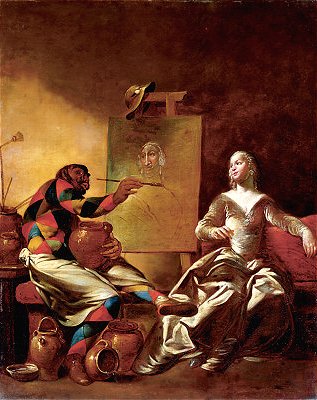 |
|
THE DISGUISES OF HARLEQUIN
Giovanni Domenico Ferretti Italian
1692-1768
SN 637-651 Oil on Canvas c
1745
by Robert Anderson
ARTIST
This artist was born into a rather well-to-do family who were quite
helpful to his career as a painter. He first studied in Imola, after that Florence and
later in Bologna an important center for the practice and teaching of academic painting.
It was here in the workshops of Felice Torelli that his work acquired its characteristic
style. He was later influenced by the painting of Sebastiano Ricci and the airy quality of
Ricci's compositions were interpreted by Ferretti in the light of his own past training.
By 1725 Ferrett had clearly achieved a distinctive, personal approach to style and the
rhythmic composition of figures.
The increased number of Ferretti's commissions accompanied his growing
reputation in Florence. In the 1730's he produced some of his most important works for
numerous Florentine churches. Ferretti's frescos of this period are outstanding for their
complexity and monumentality, represent the artist's fullest maturity and translate
solidity of form into airy and elegant figures.
The artist's sureness of technique is also seen in his secular
paintings such as the various series of Harlequinades which were done in 1742. |
SUBJECT
The subject is a series of fourteen (14) paintings of the various parts
played by the characters, Harlequin and Pulcinella. The Harlequin character was a
sharp-witted servant, one of the stock characters of the Commedia dell'arte. Pulcinella
was another of the servant characters of the Commedia dell'arte, but was more of a buffoon
than a wit like Harlequin.
It is believed that Ferretti was probably commissioned to paint the
series of twelve (12) vertical compositions and other similar series by the Accademia del
Vangelista, inspired perhaps by Goldoni's visit to Florence in 1742. Goldoni in that year
wrote two plays for the Accademia and was largely responsible for writing texts for the
previously improvised scenarios of the Commedia dell'arte.
The paintings include :
Harlequin as a Crippled Soldier, Harlequin as a Scholar, Harlequin as a Dancing Master
Harlequin Attacked, Harlequin as a Beggar, Harlequin as a Painter
Harlequin as a Glutton Harlequin as a Cook
Harlequin as a Brigand, Harlequin as a Rejected Lover, Harlequin as a Peasant
Harlequin as a Clever Valet, Pulcinella with a Cooking Pot, Harlequin as Lacemaker
PAINTING
In these paintings Harlequin appears as follows:
Crippled Soldier - Harlequin with sword, and rifle on crutches - Columbine on left with
hat in hand.
Scholar - Harlequin in black face with a large book - Columbine at right has a look of
disdain.
Dancing Master - Harlequin plays the fiddle - Columbine on left dances.
Attacked - Columbine in blue chokes black faced Harlequin.
Beggar - Harlequin holds hat out for alms.
Painter - Harlequin on left paints on easel in center - Columbine,the sitter, is on the
right.
Glutton - Woman & children watch cook in white (Pulcinella) stirs the pot over a fire.
Harlequin in blackface gobbles up food from a bowl while a
Columbine in blue tries to restrain him. Small harlequin in lower right grabs for a box on
the table.
Cook - Harlequin on left kneels to smell the contents of a pot. Columbineon right watches
and handles plates on the table.
Brigand - Harlequin with a rifle attacks Columbine on left.
Rejected lover - Harlequin in blackface is seated and the Columbine on the right pushes
his head away.
Peasant - Harlequin in a leather vest over his yellow, red and blue outfit, has a pole
over his shoulder with two baskets attached. Harlequin on the left, Columbine on the
right. A dog is present and Harlequin holds a walking stick.
Clever Valet - Harlequin talks and gestures while his master carries the bundle.
Pulcinello with Cooking Pot - Pulcinello in white in center alone.
Lacemaker - Harlequin tatting in dress of a woman - has a dress over his outfit.
Columbine on the left looks in a mirror.
HISTORICAL CONTEXT
This Harlequin series was bought by "Chick" Austin the first
curator of the museum in the 1950's. The paintings once hung in the Asolo theatre.
The Commedia del'arte was previously a religious group which then
turned to drama. It consisted of medieval Italian comedy in which the plot was written out
but the dialogue was improvised by the actors. Certain characters recur almost invariably
in the plays and the Clown, Harlequin, Columbine and Pantaloon are the prototypes of the
pantomime.
Harlequin was at first a stupid serving boy and then matured into a
conniving, wily servant seen in a diamond costume of red, blue and yellow. Columbine was
his love interest who developed from a servant into a mistress.
|